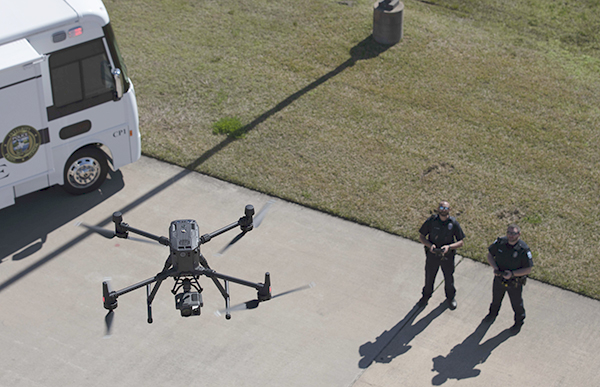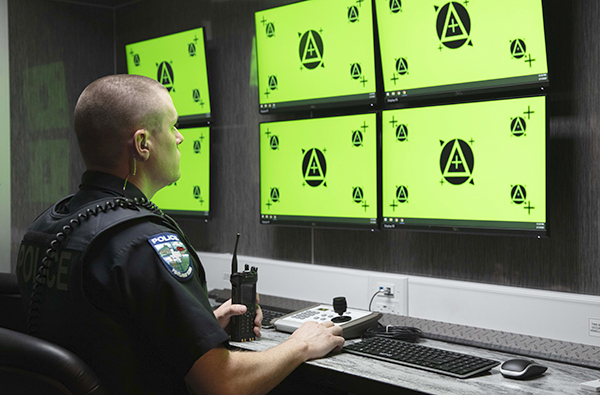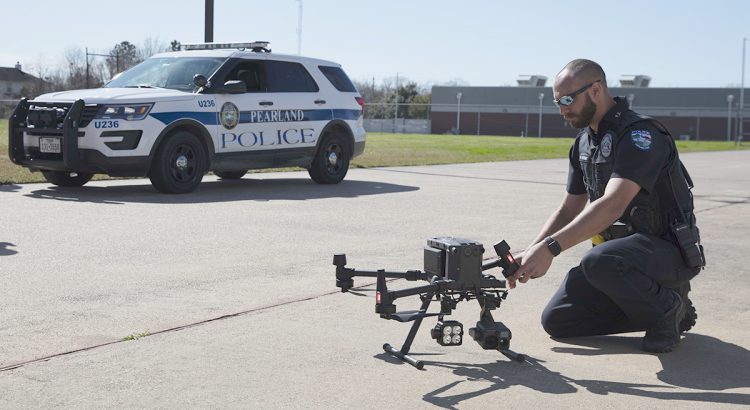Pearland Police Department has been awarded a certificate of authorization (COA) to operate its drone as first responder (DFR) program beyond visual line of sight (BVLOS) operation, eliminating the need for human visual observers (VOs). This was achieved using Iris Automation’s Casia G ground-based air surveillance system.Â
The City of Pearland is a rapidly growing city south of Houston with a population of 129,600 and 179 sworn police officers. It covers a mostly residential area of 49 square miles, and includes major urban facilities such as hospitals, schools, colleges, and shopping centers.

Pearland PD is now able to radically improve its DFR program and how it responds to emergency calls. Drones can be dispatched immediately, circumventing traffic, and offering an advanced assessment of the incident scene and reducing risks to officers. This allows first responders to be ‘on scene’ virtually, in minimum response time, allowing them to observe the scene and relay critical information to other responding officers, fire or paramedics. These ‘early eyes on scene’ can be the difference between life and death, allowing for the appropriate level of response, including reducing the over deployment of resources.
This is possible through the use of highly automated drones, centrally managed by a small number of personnel. Operating BVLOS removes the requirement for the operator to be co-located with the drone, potentially increasing the ratio of drones to operators and exponentially improving scale and efficiency.
“In a climate where personnel shortages are impacting first responders across the nation, having a fully BVLOS drone as first responder program greatly enhances resource allocation while maintaining a high level of situational awareness for first responder safety,” said Chad Randall, Assistant Chief of Police, Pearland Police Department.
The approval for its Drones as First Responder (DFR) program required the use of Iris Automation’s Casia G system as an alternative means of compliance to the 91.113 “see and avoid” requirement. This is a significant achievement in scaling drones for public safety operations and is the first Part 91 approval secured using Casia G.

“Pearland PD has been operating Casia G systems since last summer, collecting and analyzing performance data and submitting it to the FAA, which resulted in this approval,” said Jon Damush, CEO, Iris Automation. “It’s a testament to the department’s commitment to fully utilizing drones to provide more efficient services across its region and an important example of how a thoughtful CONOP combined our ground-based system mitigates air-collision risk enabling BVLOS operations. We’re proud to be a component of Pearland’s safety case and look forward to working with them and other DFR programs to provide these breakthrough capabilities.”
Charles Werner, director, Drone Responders Public Safety Alliance, said that this landmark approval for Pearland PD is a game-changer. “It enables drones as first responders to grow exponentially, helping emergency responders to maximize resources, while making communities across the nation safer.”
Complying with 14 CFR 91.113 (i.e., ‘see and avoid’) has long been the bane of the UAS industry. The removal of a pilot from the cockpit removes a layer of risk mitigation from an aviation safety case – the avoidance of mid-air collisions. Operators have been forced to explore a variety of solutions including both on-board and off-board technologies and to date, the FAA has required the use of human visual observers in any UAS operation to mitigate this risk despite humans not being the best solution to this problem.
Part 91 is the ‘general operating rules’ part of 14 CFR that governs a wide range of aviation operations, from private recreational flying to corporate charter and other commercial operations. Public Aircraft Operators, like Pearland PD, operate under 14 CFR 91, as opposed to 14 CFR 107, widely referred to as the ‘drone rule’. The approval was secured by Pearland by carefully and rigorously developing a concept of operation (CONOP) that leverages technologies to mitigate risks. This includes Iris Automation’s Casia G ground-based detect and alert system and DroneSense’s situational awareness software.
Casia G is a passive, ground-based air surveillance system, which creates a volume of monitored airspace without the need to integrate any hardware onto the drone itself. Using patented computer vision technology, Casia G alerts the Remote Pilot in Command (RPIC) to an intruder which presents a collision risk who then commands the drone to maneuver to safe zones.




